English-born guitar icon Ritchie Blackmore is one of the most influential guitar players from the 70s and is often referred to as one of the fathers of heavy metal. His unique playing style, blues-driven riffs using 4ths, classical music influence, arpeggios, and fast picking are the reason he stood out above many other contemporaries.
In the 1960s he began his career as a session guitarist, recording and touring with many bands. However, he is most famous for being one of the founding members of Deep Purple, one of the most prominent classic rock acts ever. During the mid-70s Blackmore left Deep Purple and formed another classic hard rock giant Rainbow, after the famous “Rainbow Bar and Grill” in LA.
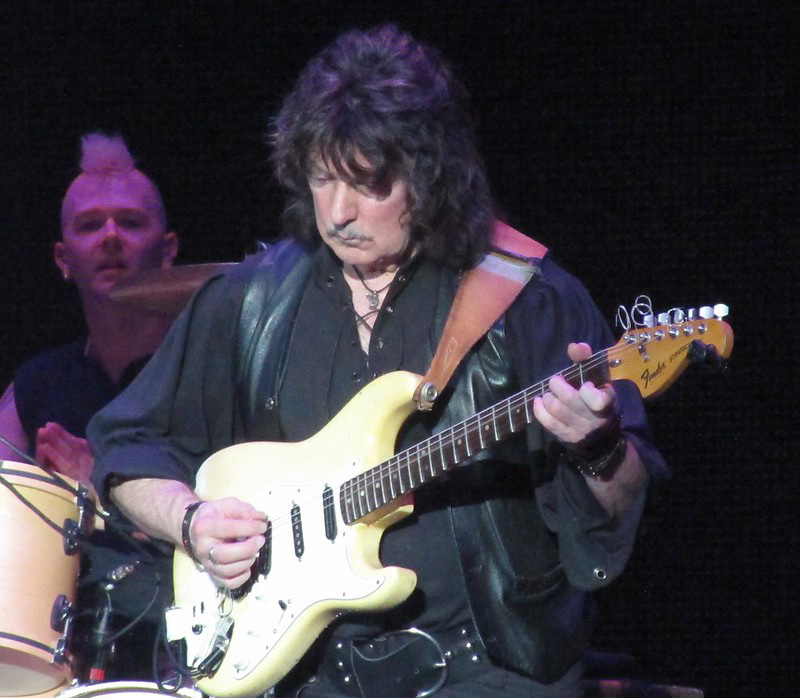
Later on, 1997 saw Ritchie along with his girlfriend, Candice Night, forming the medieval folk-inspired band Blackmore’s Night, who are still active, recording and performing live. But it’s worth noting that former Deep Purple “highway star” has left an undeniable mark on rock music as we know it, beyond classical blues-founded riffing, Blackmore innovated the guitar in a way the world was perhaps unprepared for back in the 70s.
It’s easy to assume that as time went by, many guitar players from all around the world have tried to copy and replicate Ritchie’s sound, so let’s have a look at the guitars and gear he used to conjure that Deep Purple tone we all know and love.
What Kind of Guitar Does Ritchie Blackmore Play?
Ritchie Blackmore plays Fender Stratocaster guitars, which have been his guitar of choice since the 1970s. He has a few signature and custom models to his name with Fender and, while remaining mostly devoted to playing Strats, he’s also owned and played a few other models throughout his career.
See the full list of Ritchie Blackmore guitars and gear below.
1974 Fender Stratocaster

| Finish | Olympic White |
| Years Used | 1975 to 1977/1979 to Present |
Blackmore started using this Stratocaster back in 1975 when Rainbow was just entering the recording sessions of their 1976 studio installment “Rising”. It was the first guitar of his to feature a scalloped fretboard modified by himself and ever since then he’s made sure all his fretboards are the same with his preferred concave shape.
Ritchie was last seen with that guitar in 1977 before it resurfaced again in 1979, but with completely different electronics and with a striking look. It was Ritchie’s guitar tech who introduced him to a new pickup – Schecter’s F500T. This Strat setup had two single-coil pickups and a dummy coil at the middle position. All three pickup covers, as well as the knobs, switch, and tremolo-arm tip, were black. This combination of colors – big-headed Olympic white Stratocaster, with a maple neck, scalloped rosewood fretboard, and black hardware was to become Ritchie’s trademark Strat look. Since then he used that guitar with Rainbow and later with Blackmore’s Night.
This guitar immediately became Blackmore’s definitive number one, and it eventually earned a signature model released by Fender which was modeled after it. Ritchie’s unique Stratocaster can be heard in essentially every record his made since 1976. It wasn’t until the mid-90s when a luthier accidentally tried to fix the fretboard, forcing Blackmore to re-scallop it and thus making the neck and board even thinner. He’s stated in various interviews that its use is now limited to the studio only, nevertheless, that didn’t stop him from making various stock models after it, and eventually, Fender’s signature line would also come in handy for the guitarist issuing him #1 and #2.
It’s also worth noting, this was the guitar that Ritchie brought along when he was commemorated back in 2018 in his hometown of Somerset.
1968 Fender Ritchie Blackmore Tribute Stratocaster

| Finish | Urethane Black |
| Years Used | 1969 to Present |
The first Strat Blackmore used was a second-hand Fender Stratocaster with a Telecaster neck, which he bought from an Eric Clapton roadie for $60. Shortly after he acquired it, Blackmore decided the guitar was unplayable, due to problems with intonation.
But Ritchie was somehow drawn into the Strat and didn’t hesitate to look for another, he would soon acquire this 1968 maple-necked model, one that would accompany him through some of the most iconic moments of his career. For one, this is the guitar that Blackmore used when writing, recording, and performing the one true guitar riff for “Smoke on the Water”. What’s more, he even played this exact guitar during the infamous Montreux Casino fire incident that inspired the song back in 1971.
The guitar had a black urethane finish, a 2-piece alder body, a bolt-on maple U-shaped neck, and a maple fretboard. It is equipped with 3 Custom ’68 Strat hand-wound single-coil pickups and Schaller tuners. Another feature typical for Ritchie’s Signature Strats, including this one, is that they have a three-way pickup switch. This Strat also has a four-bolt neck plate a vintage-style tremolo.
After many years with this pre-CBS era Stratocaster, Ritchie eventually retired it and kept it for special use only. He has stated that the reason for using that guitar for studio solos is that the pickups have a lot of distortion. Right down to the bone, these are the features that Fender decided to replicate when releasing the custom shop Ritchie Blackmore Fender Stratocaster in more recent years.
Gibson ES-335
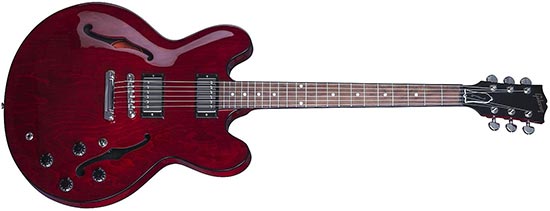
| Finish | Cherry Red |
| Years Used | 1964 to 1970 |
In the years leading to his recognition and worldwide success, Blackmore played a Gibson ES-335. This was during the mid-60s back when Deep Purple was just starting out. This was the model he used before switching to his iconic Stratocasters in ‘69, and he used the cherry-red Gibson ES-335, which he bought from a music shop near his house at the time he started playing with Deep Purple. This model is considered a classic among Gibson guitars since its first appearance in 1958.
Besides the sixties Cherry Red finish, the guitar is available in Vintage Ebony and Vintage Burst finishes. The pearloid dot inlay rosewood fingerboard and, of course, Rounded “C” mahogany neck are the attributes that make this guitar a true classic in the world of Gibsons. It is equipped with Gibson’s Calibrated T-Type humbuckers. The maple body and mahogany neck gives us the versatile ES tone that we hear on many records for over 60 years.
Here you can see Ritchie playing the ES-335 on a live version of “Child in Time” with Deep Purple in 1970. That was one of the last shows he played the ES-335.
1971 Fender Stratocaster

| Finish | Sunburst |
| Years Used | 1971 to 1980 |
Following the rise to fame and prominence of Deep Purple, Ritchie acquired several new starts to slowly but surely amp up his guitar arsenal, and so it seemed that he finally met his perfect fit with what would become his signature model ’69 Strat. Nevertheless, he needed a few rotatory pieces to his catalog, and so this ’71 Stratocaster was picked up on the road and on its way to an American tour the same year of its manufacture.
Ritchie had two different Sunburst Strats, one with a maple neck that was often seen during his early tenure with Deep Purple and another one with a rosewood fretboard that would go on to accompany him with Rainbow.
Fender Stratocaster/Stillwell L-450 Stratocaster
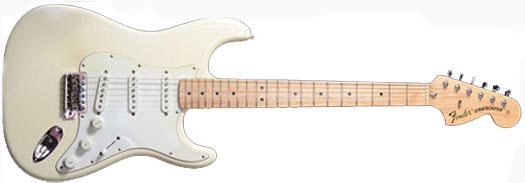
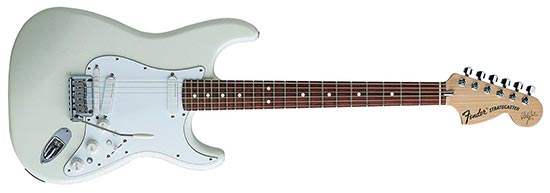
| Finish | White |
| Years Used | 1973 to 1975/1980 to Present |
Back in 1973, Ritchie had acquired a considerable amount of stock Stratocasters, however so it seemed that the white ones were his favorites during the BURN recording sessions and tour. Blackmore had seemingly no attachment for these models, as he disposed of them with his destructive on-stage antics and continuously smashed and bashed whenever there was a televised opportunity. Furthermore, Ritchie’s white Strat murders became immortalized back in 1974 during the California Jam show where he ultimately dropped his ash white guitar from the ledge of the stage before switching to yet another white one.
It is known, however, that there is one particular white Stratocaster Ritchie grew fond of, and it was the one kept with its original form for studio and certain shows. On another hand, some of its stock siblings wouldn’t fare so well. Many other white Strats would later on become test subjects for Blackmore. But it wasn’t until he founded Blackmore’s Night that said “laboratory” sessions would become increasingly common for Ritchie.
During the mid-80s the Lawrence L-450 pickup (single-coil-sized humbucker) was released and soon (in 1986) was installed in one of Ritchie’s trademarked colored Strats, needless to say whenever there was a pickup experiment, that guitar would become his main for a while. Much of this trial and error period would eventually lead to Fender taking notice of Ritchie’s and collaborator Dawk Stillwell’s work, who designed the entire setup for only so many guitars. Eventually, the L-450 Stillwell Stratocaster would become one of Blackmore’s signature Stratocaster models, the first of two.
1977 Fender Stratocaster

| Finish | Olympic White |
| Years Used | 1978 to Present |
In 1978 Blackmore started using his first hum-canceling guitar (pickups designed by Dawk Stillwell), this ’77 Olympic white Fender Strat with a scalloped rosewood fretboard and black pickguard. This was also the first time Ritchie started using a non-active “dummy” pickup at the middle position, since (he has stated that) he doesn’t use the middle position at all.
This guitar was also one of his first guitars with (as his guitar techs used to call it) Master-Tone-Circuit (MTC) wiring. Ritchie has also said that with the MTC he had been able to get a creamier lead tone. From that point on, all of Blackmore’s Strats have featured the MTC wiring. Furthermore, this guitar was used with Rainbow when Dio (Ronnie James) was the lead singer of the band, throughout Graham Bonnet era, all the way to early Joe Lynn Turner days, when Ritchie decided to replace the black pickguard with a white one. He still uses this guitar with Blackmore’s Night. This is easily one of the most iconic Ritchie Blackmore guitars of all time.
Alvarez-Yairi Ritchie Blackmore Signature
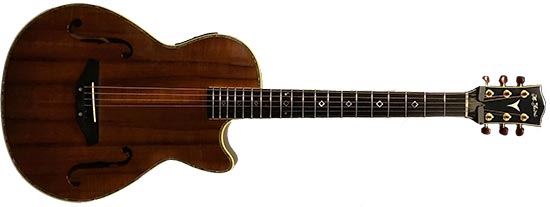
| Finish | Flamed Koa |
| Years Used | 1997 to Unspecified |
Despite Ritchie being an iconic Stratocaster axeman, this custom-made guitar to his name has become just as iconic to his solo act as his black “Smoke on the Water” six-string.
Blackmore has used this Alvarez-Yairi acoustic-electric guitar since he formed Blackmore’s Night and it’s his main go-to when we’re talking acoustic. This guitar has a flamed Koa top, mahogany body, ebony fretboard, and a Fishman Presys preamp system, and its main trait is its peculiar troubadour sound, one that Blackmore is obviously fond of.
Over the years, this Yairi guitar has served Ritchie and his wife to create some medieval folk tunes that have set them apart from the modern music scene.
Timetable Showing Each Guitar Ritchie Blackmore Has Played at Each Point of His Career
| Make | Model | Color/Finish | Years |
|---|---|---|---|
| Gibson | ES-335 | Cherry Red | 1964 to 1970 |
| Fender | Ritchie Blackmore Tribute Stratocaster | Urethane Black | 1969 to Present |
| Fender | 1971 Stratocaster | Sunburst | 1971 to 1980 |
| Fender | Stratocaster/Stillwell L-450 Stratocaster | White | 1973 to 1975/1980 to Present |
| Fender | 1974 Stratocaster | Olympic White | 1975 to 1977/1979 to Present |
| Fender | 1977 Stratocaster | Olympic White | 1978 to Present |
| Alvarez-Yairi | Ritchie Blackmore Signature | Flamed Koa | 1997 to Unspecified |
Ritchie Blackmore Amps Overview
VOX AC-30
Years Used: 1966 to 1973
When Blackmore started playing with Deep Purple he used a VOX AC-30 combo amp. For his tone, he has stated Ritchie uses a treble booster with the volume knob all the way up. The VOX AC-30 was first manufactured in 1958 with two channels: “Normal” and “Vib-Trem” channels. Some of the newer models even have three channels. Originally, the AC-30 had a single 12-inch Goodmans 60-watt speaker. Later, it got its classic configuration with 2×12-inch Goodmans Audiom 60.
Around 1970, Ritchie wanted bigger and louder amps, so he went to a Marshall factory in Bletchley, near his residence, and asked them to devise a Marshall circuit for him that would sound similar to his VOX AC-30. He would play the different setups there for hours, however, according to the man himself his efforts were unsuccessful.
Eventually, Ritchie was approached by one of the workers who simply told him “What we’re going to do is get one of our combo amps and we’ll take out the innards and put in the Vox innards. So you’ll actually be playing a Vox, but it’ll say, Marshall”.
Popular Related Article: What Guitar Did Glen Buxton Play?
JMP Marshall Major 200W
Years Used: 1973 to Unspecified
When Ritchie started using the Marshall Major amps, the guys at Marshall wanted to design an amp that would have the tone he preferred. So they put an extra output stage into one of the 200-watt amps to get more distortion and overall a fatter sound. The result was a loud amp turned into a 280-watt piece of catalog not bad at all.
Marshall Super Lead 100-watt
Years Used: Unspecified to Present
Blackmore has often used Marshall Super Lead 100-watt heads since he started Blackmore’s night, they would often rotate on stage, but it. This model was first introduced in 1965 in combination with 4×12-inch cabinets. It is the most famous Plexi Marshall model. KT66 tubes were the first choice for this amp until they were replaced with EL34 in 1966. It also has three ECC83 preamp tubes. The Super Lead has 100 watts of power, four inputs, and two channels – rhythm and lead.
Popular Related Article: Yngwie Malmsteen Guitars and Gear
Engl E650 Ritchie Blackmore Signature
Years Used: 1995 to Present
When Blackmore was living in Connecticut, around 1994, a friend introduced him to Engl amps. He hasn’t tried one until then but decided to give them a chance, since he has always liked small combo amps, because, as he says, you can contain the sound more. Since then, Ritchie has used various Engl amps until they made him a signature model, Engl E650, which he still uses.
This Engl E650 Ritchie Blackmore Signature 100 has 4 channels: Clean, crunch, soft lead, and heavy lead. It is an all-tube head with 4 Engl ECC83/12AX7 preamp tubes and 4 Engl 6L6GC output tubes. Additionally, it has 3 sound options: bright, contour and Gain Lo/Hi, gain, for clean and lead channels, 3-band EQ, lead presence, lead volume, Master A, Master B, and an FX loop balance.
Ritchie Blackmore Pedals and Effects Overview
Gibson Maestro Fuzz-Tone
Years Used: 1960s
Ritchie used this pedal during the ‘60s. Maestro Fuzz-Tone is the godfather of all fuzz pedals. The first Maestro Fuzz-Tone was introduced in 1962. The interesting thing is that it was created almost by accident. In 1960, Marty Robbins was recording a song with the session guitarist Grady Martin. Apparently, he was given a custom-built amp and one of the transformers developed an open primary, which is believed to cause that fuzzy sound. After some time, the transformer died and his engineer tried to recreate that fuzz tone with transistors. When he succeeded, he presented it to Gibson and that was when Maestro Fuzz-Tone pedal was born.
Popular Related Article: Paul Stanley Rig Rundown
Sola Sound Pro MK II Tone Bender
Years Used: 1960s
Blackmore used the Sola Sound Tone Bender pedal for recording and touring during his first couple of years in Deep Purple. You can hear this pedal throughout the first three Deep Purple albums. Sola Sound Professional MK II Tone Bender was first designed in 1964 and it was based on the Gibson Maestro Fuzz-Tone. It is a rare fuzz-pedal, but it was very popular during the 1960s among many guitar players since it was a new guitar effect and had a lot of gain.
Vox 847 Wah Pedal
Years Used: 1960s to Unspecified
Ritchie doesn’t use wah-wah pedals very often. However, the first wah-wah pedal he used during the early days in Deep Purple was the Thomas Vox 847.
Also known as the Vox “Clyde McCoy”, it was first introduced in 1967 and designed by the Thomas Organ Company, was the original wah pedal. Initially, there were two versions of the pedal produced, on the first one there was a drawing of the jazz trumpeter Clyde McCoy, and the second version contained the name “Clyde McCoy” on the plate on the back of the pedal.
Hornby Skewes Treble Booster
Years Used: 1960s to 1974
Blackmore used various Hornby Skewes Treble Boosters since he started playing with Deep Purple, in 1974. This pedal contributed to his classic tone that we hear when we listen to the colossal albums “In Rock” and “Machine Head”. He used the treble booster, not only to get a little bit more treble but also to overdrive his amps, in essence, to get more distortion. During “Machine Head” recording sessions, Deep Purple wanted more distorted organ sound, so Ritchie suggested to Lord to plug his Hammond organ into the Hornby Skewes Treble Booster and through his Marshall amp. And that is how he got his powerful distorted Hammond sound on the “Machine Head” album.
Dunlop Dallas Arbiter Fuzz Face pedal
Years Used: 1970s to Unspecified
The Dunlop Dallas Arbiter Fuzz Face is yet another fuzz pedal that Blackmore has used since the beginning of the 1970s. The pedal is in the form of a big smiley face, hence the name Fuzz Face. It was first introduced in 1966. And, as with most early fuzz pedals, the first series used germanium transistors which were later replaced with silicon transistors to get a bit raspier sound.
WEM Watkins Copycat Tape Echo
Years Used: 1970s to 1974
In the early 1970s, Blackmore also used a WEM Watkins Copycat Tape Echo unit for delay effects. First released in the 1960s, this echo unit still remains in production today. Initially, it was designed for electric guitars but soon became very popular and an integral part of many studios worldwide.
EMS Synthi Hi-Fli
Years Used: Unspecified
In the 1970s Ritchie experimented with guitar synthesizers. One of them was the EMS Synthi Hi-Fly which was built for EMS in 1971. Although has been introduced as a synthesizer, it is actually an analog multi-effect processor. It has a top boost, an octave shift, a buzz switch, a phase filter, and pedal switches.
Moog Taurus
Years Used: 1973 to 1997
Ritchie has also used a Moog Taurus bass pedal, especially for his solos live. The Moog Taurus is a foot-operated analog synthesizer. It was first introduced by Moog Music in 1975 and can be used with guitars or keyboards.
AIWA TP-1011 Tape Machine
Years Used: 1974 to Present
In 1974 Blackmore replaced the echo pedals that he used with an AIWA TP-1011 Tape Machine, which he modified from a regular tape recorder into an echo unit. Because the recorder boosted the amp signal he also got a little distortion. He still uses this tape machine to this day.
Roland GR-700 Guitar Synthesizer
Years Used: 1983 to Present
In the mid-1980s Ritchie started using analog guitar synthesizers, mainly Roland GR-700 Guitar synth. Introduced in 1984, the Roland GR-700 was the zenith of early guitar synths. It features a digital CPU and a natural, analog synthesizer engine for warmer sounds.
1960s Arbiter Soundette Echo Box
Years Used: 1970s to 1974
On the first couple of albums with Deep Purple, Blackmore used an Arbiter Soundette Echo Box for delay effects. It was first introduced in the 1960s. It looks similar to the Arbiter Add-a-Sound, with three pots: Volume, Echo, and Duration, three buttons for the effects on the right side of the pedal, as well as two Inputs, Output, and a Footswitch input.
Ritchie Blackmore Guitar Picks and Accessories
Dunlop Tortex Home Plate Guitar picks
Years Used: 1970s to present
An interesting thing is that Blackmore used unusual guitar picks – Home Plate Guitar picks.
Also, a fun fact is that original Blackmore picks are actually very hard to find, because he only uses a few picks, plays the same picks for a long time, and refuses to hand them out to fans or through them in the audience during live shows.
Wrap Up
Having a long-lasting career, for over half a century, and still kicking, Ritchie Blackmore remains at the top, as one of the greatest rock guitar players of all time and living rock legend. He is the main culprit for some of the most iconic rock songs, guitar riffs, and solos in the Rock N’ Roll history: “Smoke on the Water”, “Lazy”, “Black Night”, “Burn”, “Man on the Silver Mountain”, just to name a few.
Blackmore has many achievements and contributions to rock music in general. He was inducted into the Rock and Roll Hall of Fame. The solos for “Highway Star” and “Lazy” were ranked 19th and 74th on the “100 Greatest Guitar Solos of all time” list in Guitar World Magazine. Additionally, He is also given credit for being the predecessor of the Neo-classical metal genre and, undoubtedly, an influence on the guitar shredders that emerged in the 1980s, and many generations of guitar players to come.

My name is Chris and I’ve had a passion for music and guitars for as long as I can remember. I started this website with some of my friends who are musicians, music teachers, gear heads, and music enthusiasts so we could provide high-quality guitar and music-related content.
I’ve been playing guitar since I was 13 years old and am an avid collector. Amps, pedals, guitars, bass, drums, microphones, studio, and recording gear, I love it all.
I was born and raised in Western Pennsylvania. My background is in Electrical Engineering, earning a Bachelor’s degree from Youngstown State University. With my engineering experience, I’ve developed as a designer of guitar amplifiers and effects. A true passion of mine, I’ve designed, built, and repaired a wide range of guitar amps and electronics. Here at the Guitar Lobby, our aim is to share our passion for Music and gear with the rest of the music community.

Didn’t find what I was looking for because I was watching a live concert where ritchie blackmore was playing a fender strat scalloped neck with something black attached near to the bridge -can’t find out what it was.